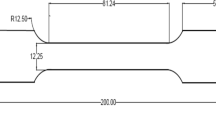Abstract
Weld quality is a very important working aspect of the manufacturing and construction industries. In this research work, an attempt has been made to optimize the parameters of activated tungsten inert gas (A-TIG) welding of sintered hot-forged AISI 4135 steel produced through the powder metallurgy route. Experiments were performed based on Taguchi L9 orthogonal array. Response surface methodology was used to create regression equations, and process parameters were optimized using genetic algorithm (GA) and simulated annealing (SA). Process parameter optimization is multi-input to single output (tensile strength), in which the quality of output depends upon input parameters like current, voltage, welding speed, and gas flow rate. The present study was conducted to maximize the output of the A-TIG welding of sintered hot-forged AISI 4135 steel and fix the input parameters. The results indicate that the voltage and current have a maximum influence on tensile strength in A-TIG-welded joint. Confirmation experiments have also been conducted to validate the optimized parameters.
Similar content being viewed by others
References
Lindberg C (1999) Adv Powder Metall Part Mater 2(7):229–243
Karlsson H, Nyborg L, Berg S (2005) Surface chemical analysis of prealloyed water atomised steel powder. Powder Metall 48(1):51–58
Sakthivel T, Vasudevan M, Laha K, Parameswaran P, Chandravathi KS, Mathew MD, Bhaduri AK (2011) Comparison of creep rupture behaviour of type 316L(N) austenitic stainless steel joints welded by TIG and activated TIG welding processes. Mater Sci Eng A 528:6971–6980
Kulikov FR (1968) The use of fluxes for titanium alloy welding. Avtomaticheskaya Svarka 4:9–12 (in Russian)
Salak A (1997) Ferrous powder metallurgy. Cambridge International Science Publishing, Cambridge
Hadrboletz A, Weiss B (1997) Fatigue behavior of iron based sintered materials. A review. Int Mater Rev 42:1–44
Jayabharat K, Ashafaq M, Venugopal P, Achar DRG (2007) Investigation on the continuous drive friction welding of sintered powder metallurgical (P/M) steel and wrought copper parts. Mater Sci Eng 454–455:114–123
Chawla N, Deng X (2005) Microstructure and mechanical behavior of porous sintered steel. Mater Sci Eng 390:98–112
Kurt A, Ates H, Durgutlu A, Karacif K (2004) Exploring the weldability of powder metal parts. Welding J 83(12):34–37
Savitsky MM, Leskov GI (1980) Mechanism of effect of electronegative elements on penetrating capacity of arc with tungsten cathode. Avtomatich Svarka 9:17–22
Gurevich SM, Zamkov VN (1966) Welding titanium with a non-consumable electrodes with fluxes. Avtomatich Svarka 12:13–16
Lucas W, Howse DS (1996) Activating flux—increasing the performance and productivity of the TIG and plasma processes. Weld Met Fabr 64(1):11–17
Fujii H, Sato T, Lua S, KiyoshiNogi (2008) Development of an advanced A-TIG (AA-TIG) welding method by control of Marangoni convection. Mater Sci Eng A 495:296–303
Gurevich SV, Zamkov VN, Kushnirenko NA (1996) Improving the penetration of titanium alloys when they are welded by argon tungsten arc process. Automat Weld l.9:1–4
Vasudevan M, Bhaduri AK, Baldev Raj (2008) Development and evaluation of activated flux for TIG welding of type 304LN and type 316LN stainless steel. IIW-Int. Conference, Chennai, India, 211–218
Yushchenko KA (1993) A-TIG welding of carbon-manganese and stainless steels. Int Con on Welding Technology, Paton Institute, Cambridge
Palanichamy P, Vasudevan M, Jayakumar T (2009) Measurement of residual stresses in austenitic stainless steel weld joints using ultrasonic technique. Sci Tech Weld Join 14(2):166–171
Ross P (1988) Taguchi technique for quality engineering. McGraw-Hill, New York
Myers RH, Montgomery DH (1995) Response surface methodology. Wiley, New York, 705p
Kim D, Rhee S (2001) Optimization of arc welding process parameters using a genetic algorithm. Weld J 80(7):184–189
Montgomery DC (1984) Design and analysis of experiments, 2nd edn. Wiley, New York
Holland J (1975) Adaptation in natural and artificial systems. The University of Michigan, Ann Arbor
Montgomery DC (2009) Design and analysis of experiments, 7th edn. Wiley, New York
Kirkpatrick S, Gelatt CD, Vecchi MP (1983) Optimization by simulated annealing. Science 220:671–680
Metropolis N, Rosenbluth A, Rosenbluth M, Teller A, Teller E (1953) Equation of state calculations by fast computing machines. J Chem Phys 21:1087–1092
Corana A, Marchesi M, Martini C, Ridella S (1992) Minimizing multimodal function of continuous variables with the simulated annealing algorithm. ACM TOMS 13:262–280
Miki M, Hiroyasu T, Keiko O (2002) Simulated annealing with advanced adaptive neighborhood. Proc. 2nd Int workshop on intelligent systems design and applications, 113–118, 2002.
Miki M, Hiwa S, Hiroyasu T (2006) Simulated annealing using adaptive search vector. IEEE conference on cybernetics and intelligent systems, 1–6
Fisher RA (1925) Statistical methods for research worker. Oliver & Boyd, London
Author information
Authors and Affiliations
Corresponding author
Rights and permissions
About this article
Cite this article
Joseph, J., Muthukumaran, S. Optimization of activated TIG welding parameters for improving weld joint strength of AISI 4135 PM steel by genetic algorithm and simulated annealing. Int J Adv Manuf Technol 93, 23–34 (2017). https://doi.org/10.1007/s00170-015-7599-8
Received:
Accepted:
Published:
Issue Date:
DOI: https://doi.org/10.1007/s00170-015-7599-8




